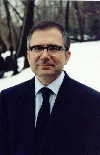Martin Gardner died on May 22, 2010. There will be many articles and tributes to him in the coming weeks and months, but probably few will be from proponents of the paranormal. Gardner generally was not liked by them, and the feeling was mutual.
He had a real dislike for some researchers, including J.B. Rhine and Russell Targ (as well as some members of Targ’s family).1 Nor was he able to maintain friendly relations with moderate skeptic Marcello Truzzi. Gardner was a “hard-line” debunker, and his writings were frequently laced with invective, sarcasm, and ridicule—a style less suited for scholarly journals but more for zines such as Saucer Smear (Gardner was a non-subscriber to Smear, and an occasional contributor).2
But the implications of the paranormal debates go far beyond the personalities, foibles, and animosities of those involved in the disputes. Gardner is too important to be dismissed, and the twentieth-century controversy over the reality of psychic phenomena cannot be understood without him.3
He dealt with the issues frequently, in depth, and for more than half a century. He was passionate about the topic, and it is not too strong to say that paranormal claims enraged him. In its own way, the paranormal was part of his life, and part of him. His writings, and also his person, merit attention. The emotion that paranormal controversies generates, and the schisms they provoke, are key to understanding the anti-structural nature of the phenomena.4
I grew up reading Gardner’s Mathematical Games column in Scientific American, long before I had any interest in the paranormal. His occasional allusions to the paranormal sometimes puzzled me, but I didn’t pay much attention to them. After I developed an interest in parapsychology and began reading The Zetetic, Skeptical Inquirer, and Zetetic Scholar, I became familiar with the controversies, and of course, with Gardner’s role. His clear, vigorous (even vicious!) prose, was fun to read, if one was not too close to the receiving end. Newsweek magazine commented: “Gentle as he is, he is driven almost beyond satire...he wields Ockham’s razor like a switchblade.”5
My own opinion of Gardner is comparatively favorable, considering the views of most paranormal proponents. He made important contributions to psychical research, especially when he pointed out that parapsychologists needed a knowledge of magic. As I became professionally involved in parapsychology, I found his point to be largely ignored.6 His writings were a significant influence on my thinking and orientation to psychic claims. When I critiqued the research with Bill Delmore, which was highly regarded within parapsychology, Gardner provided very useful information.7
Proponents, as well as debunkers, have almost entirely avoided addressing his religious views (though I’ve made some attempt). Gardner’s struggles over his religious beliefs had a profound impact on his intellectual life. He understood that parapsychology had implications for religion, and he was uncomfortable with them. In fact, he wrote that some parapsychology experiments could be blasphemous, going on to add, “Let us not tempt God.”8
My comments above have been brief; they are meant only as an introduction to the more extended analysis included in The Trickster and the Paranormal. There I devoted more than 14 pages to Gardner, far more than for any other individual. The section appeared within the chapter on reflexivity, partly to provide a respite from that highly abstract topic and partly because Gardner was an important popularizer of the topic of self-reference. The section, which is critical but also appreciative, is now online.
Click here for section on Martin Gardner in The Trickster and the Paranormal (PDF file, 230KB)
Endnotes
1. Gardner’s animosity can be seen in his article “Notes of a Fringe-Watcher: Distant Healing and Elisabeth Targ” (Skeptical Inquirer, Vol. 25, No. 2, March/April 2001, pp. 12-14). Russell Targ quoted at length from the article in his Do You See What I See?: Memoirs of a Blind Biker (Charlottesville, VA: Hampton Roads Publishing Company, Inc.; 2008. See pages xxx-xxxii.), demonstrating Gardner’s mean spiritedness.
2. Saucer Smear is the insider’s gossip zine of ufology, covering its scandals, fights, hoaxes, recriminations, lawsuits, felony convictions, etc. One could not become a “subscriber” to Saucer Smear, only a “non-subscriber.” Now in its 57th year, Smear is still edited by the court jester of ufology, James Moseley, who had a close association with James Randi.
3. Gardner was one of the founding members of the Committee for the Scientific Investigation of Claims of the Paranormal (CSICOP, now the Committee for Skeptical Inquiry [CSI]). Jerome Clark justifiably called him “the godfather” of the skeptics movement (Clark, Jerome. [1990]. Skeptics and the New Age. In J. Gordon Melton, Jerome Clark, & Aidan A. Kelly [Eds.], New Age Encyclopedia [pp. 417-427]. Detroit, MI: Gale Research. See page 420.). For more on CSICOP, see my “CSICOP and the Skeptics: An Overview” (Journal of the American Society for Psychical Research, Vol. 86, No. 1, 1992, pp. 19-63), which is available on my website.
4. The ubiquitous controversies and schisms in paranormal fields are captured by the word anti-structure, a term derived from the anthropological study of ritual. The concept explains characteristics of the trickster figure of mythology as well as properties of paranormal phenomena.
5. Adler, Jerry; with Carey, John. (1981, November 16). The Magician of Math. Newsweek, Vol. 98, p. 101.
6. As magician-academics such as Marcello Truzzi, Ray Hyman, Richard Wiseman, Daryl Bem, and Peter Lamont became more active in parapsychology, greater attention was given to the problem of deception.
7. Hansen, George P. (1992). The Research With B.D. and the Legacy of Magical Ignorance. Journal of Parapsychology, Vol. 56, No. 4, pp. 307-333. Available on my website.
8. Gardner, Martin. (1983). The Whys of a Philosophical Scrivener. New York: William Morrow. See page 23.
Subscribe to:
Post Comments (Atom)


No comments:
Post a Comment